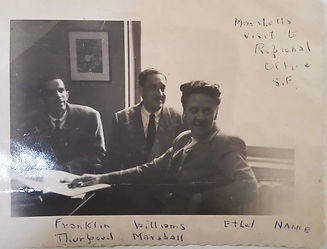ETHEL RAY NANCE
 |  |  |
|---|---|---|
 |  |  |
 |
Ethel Ray Nance was born on April 13, 1899, in Duluth. She was the youngest of four children born to William H. Ray, an African American native of North Carolina raised in Iowa by a German family, and Inga Nordquist Ray, a Swedish immigrant. Ethel and her family faced racism from neighbors and community members. Her father, William, was a major influence in her life often reading aloud to his children about African American struggles and the importance of standing up again injustices.

Ten Intriguing Facts about Ethel Ray Nance
Adolescence & Early Work

In high school, Ethel trained in stenography, a skill that would become pivotal to her groundbreaking career.
In 1918, she began working as a stenographer for the Minnesota Forest Fires Relief Commission, which was helping the 50,000 victims of the Cloquet, Duluth, and Moose Lake Fires.


A defining
Civil rights mission
In 1921, just a year after a white mob brutally lynched three Black men in Duluth, Minnesota—Ethel's journey into civil rights activism took a defining turn. At the request of her father, she traveled to Minneapolis on a mission that would change the course of her life: to persuade W.E.B. DuBois, the esteemed scholar and civil rights leader, to speak at a Duluth NAACP meeting.
Ethel carried with her not just her father’s request, but the weight of a grieving and outraged community. Her determination moved DuBois, who agreed to speak in Duluth. That moment of connection sparked a lifelong friendship between the two—a bond forged in shared purpose and a deep commitment to justice.
breaking barriers
By 1923, Ethel's previous work with the Minnesota Forest Fires Relief Commission led to her hire as a stenographer for the State Legislature. She gained national recognition for as the first African American to break the secretarial color barrier in the legislature, which brought her to the attention of the Kansas City Urban League.
breaking the secretarial color

Harlem Renaissance
_.jpg)
A party on the roof of 580 St. Nicholas Ave. in Harlem. From left to right, attendees included Ethel Ray Nance, Langston Hughes, Helen Lanning, Pearl Fisher, Regina Anderson Andrews, Rudolf Fisher, Luella Tucker, Clarissa Scott Delany, Esther Popel, Hubert Delany, Jessie Fauset, Marie Johnson and E. Franklin Frazier. Schomburg Center/New York Public Library
In 1924, Ethel joined the Kansas City Urban League where she met Charles S. Johnson, then Director of Research of the New York Urban League and editor of the Opportunity, the League's prominent magazine. He invited her to New York to work as his secretary, writer, researcher, and editor.
Ethel moved into a 5th floor apartment at 580 St. Nicolas Avenue in Harlem, affectionately known as Dream Haven. She lived with roommates - Louella Tucker and Regina Anderson Andrews, the first African American to head a branch of the New York Public Library. Anderson's 135th Street Branch is now known as the Schomburg Center for Research in Black Culture.

Dream Haven became a vibrant salon for the Harlem Renaissance’s most influential minds. Guests like Langston Hughes, W.E.B. Du Bois, and even Zora Neale Hurston, who stayed on their couch for a time. The apartment became a cornerstone of cultural synergy, known as the Harlem West Side Literary Salon.
Community & social justice

Upon Ethel's return, from Harlem, she to Minneapolis, from Harlem, continued her public service, becoming the associate head resident for the historic Phyllis Wheatley House. Wheatley, founded in 1924, was the first settlement house to provide social services to African Americans.

Law enforcement Pioneer


In 1928, Ethel was hired by the Minneapolis Police Department, making her one of the first African American policewomen to serve in Minnesota's Women's Bureau.
Advocacy On the World Stage
In 1945, Ethel relocated from Seattle to San Francisco to serve as secretary to W.E.B. DuBois, during his appointment as a consultant to the U.S. Delegation to the United Nations Organizing Conference.

Her advocacy continued on the West Coast, where she worked with the NAACP’s West Coast Regional Office and found the San Francisco African American Historical and Cultural Society.
JUSTICE

In 1952, Ethel joined the NAACP-GI Assistance Committee in the California Bay Area which raised more than $5000 to support, Thurgood Marshall’s investigation into the court-martials of Black Servicemen in Korea and Japan. Ethel played a vital role by transcribing key meetings and interviews.
LIFE-LONG learner

In 1978, at the age of 79, Ethel exemplified her dedication to lifelong learning by earning a Bachelor of Arts degree from the University of San Francisco, becoming the oldest person to achieve this milestone. Her accomplishment stands as a testament to her power of perseverance and the belief that education knows no age limits.
A Resilient journey
Ethel Ray Nance passed away in 1992 at the age of 93, leaving behind a profound legacy of justice, resilience, and service. In recognition of her contributions, April 13,2023, was declared Ethel Ray Nance Day in the city of Duluth, Minnesota. Her story continues to inspire generations to stand for equality, lead with integrity, and never give up on the fight for justice.

